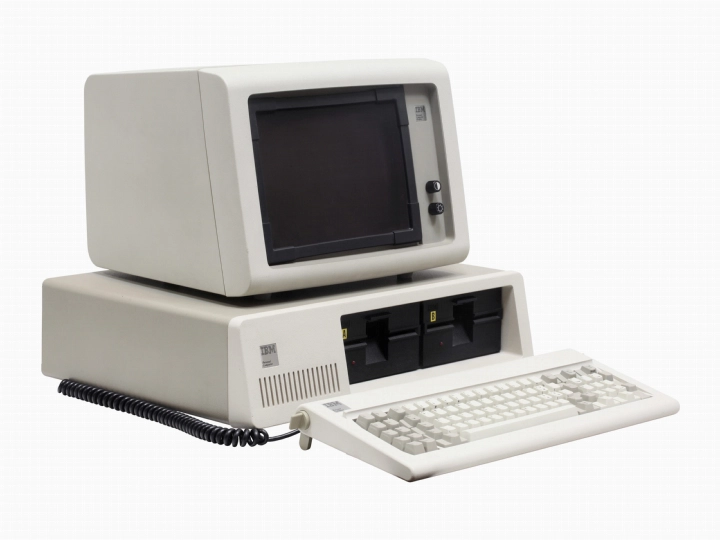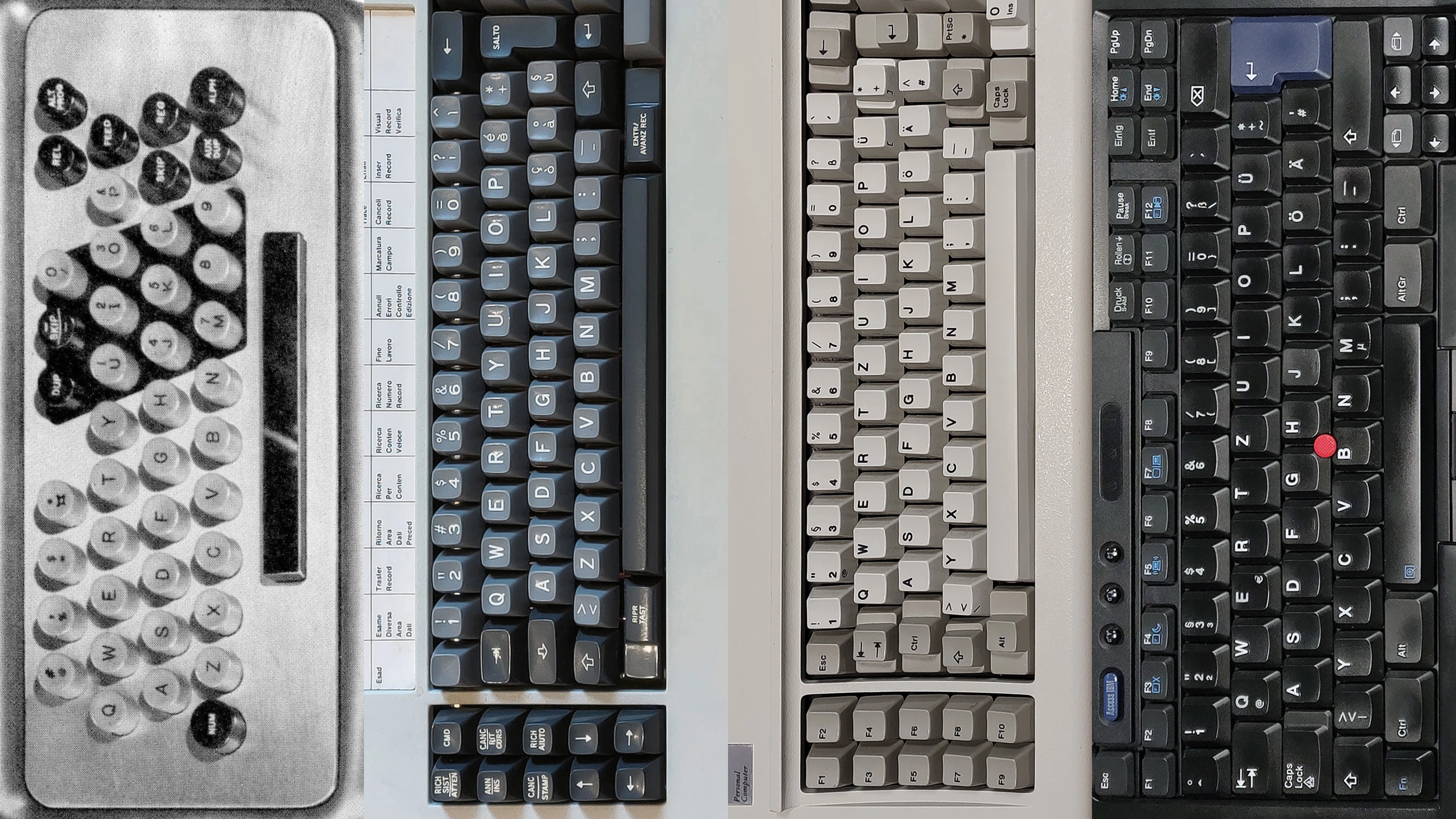A timeline of IBM keyboard history
The IBM and family keyboard timeline is an illustrated overview of some of the most important events affecting IBM, Lexmark, Unicomp, Lenovo and Toshiba Global Commerce Solutions keyboards. This includes notable keyboard releases and withdrawals, corporate history like company founding, divestures and change in OEMs, and patents. Due to their relationship and impact on the keyboards around them, host devices such as personal computers, terminals, consoles and typewriters also appear throughout the timeline. 144 events have been recorded for the "show all" versions of the timeline.
After concluding the IBM System/23 Datamaster's development, IBM begins work on the IBM Personal Computer. This includes its keyboard, which was derived from the then-still-unreleased Model F-based IBM System/23 Datamaster Keyboard Assembly.

IBM launched the original Personal Computer, along with it, the IBM Personal Computer Keyboard. Also known as the "Model F/XT", the IBM PC Keyboard is the most common Model F keyboard variant.
[1] The IBM 3270 Personal Computer becomes available. The 3270 PC is essentially an IBM Personal Computer XT with additional hardware and software to emulate an IBM 3270 terminal. The Model F-based IBM 3270 Personal Computer Converged Keyboard was IBM's first 122-key Converged Keyboard design and IBM's earliest host-connected keyboard.
[2] IBM announces the Portable Personal Computer, a 'luggable' version of the IBM Personal Computer XT with an integrated 9" amber display designed to compete with the original Compaq Portable. It includes the Model F-based IBM Portable Personal Computer Keyboard, which is based on the existing IBM Personal Computer Keyboard but uses a different plug and has an all-plastic covet set and an aluminium base plate that reduces its weight.
[3] IBM introduces the PCjr, a small, low-cost PC designed for "home and educational environments and for personal productivity applications." Its keyboard, the PCjr Cordless Keyboard, has 62 "chiclet" style keys, rubber-dome keyswitches and infrared connectivity. The PCjr would turn out to not be very successful, and its original keyboard design considered to be one of IBM's worst.
[ASK] IBM launched the Personal Computer AT (PC/AT), along with it, the IBM Personal Computer AT Keyboard. Also known as the "Model F/AT", this would be the last entirely new Model F keyboard design.
IBM introduces the revised PCjr Cordless Keyboard to address major complaints regarding the original "chiclet" style design. It still has 62 keys and infrared connectivity, but it now has more traditional style keys and nomenclature is printed on the keys instead of an overlay surrounding them.
[4] IBM announces the PC/AT-based 7531 and 7532 Industrial Computers. The IBM Enhanced Keyboard via the IBM 7531/7532 Industrial Computer Keyboard makes its first official appearance. The Enhanced Keyboard introduces the full-size/100% form-factor and the basis of the ANSI and ISO physical layouts that remain the standard today.
[5] IBM introduces the PC Convertible, an early laptop-style entry in the original IBM Personal Computer family. It features a modular LCD and has a rear extendable bus interface that allows the user to attach various add-ons such as a printer or CRT Display Adapter one after the other. It also features an Alps-made keyboard assembly with Alps SKCM "Brown" (most keys) & SKCL Compact (half-height keys) keyswitches.
[ASK] IBM introduces the PC/XT Enhanced Keyboard (pictured) and PC/AT Enhanced Keyboard, initially for the Personal Computer XT 'S' models and Personal Computer AT Expanded respectively as an option. They are essentially pearl-white adaptations of the IBM 7531/7532 Industrial Computer Keyboard, and are also the first Model Ms for home and business PCs to become available.
[ASK] IBM introduces the Personal Computer/2 (PS/2) series of PCs. With them, the IBM PS/2 Enhanced Keyboard that would become the most common buckling-spring Model M variant and possibly one of the most famous keyboards of all time.
[ASK] IBM brought its Model M Space Saving Keyboard design to the IBM Personal System/2 family, starting with the IBM PS/2 Model 25 models 001 and 004. The PS/2 SSK is the first modern PC tenkeyless keyboard and used a layout based on the Enhanced layout but with a numeric keypad overlaid across various alphanumeric keys.
[ASK] IBM announces two new models of the IBM Personal System/2 Model 30, models R02 and R21, intended as teller workstations for financial institutions. Hardware-wise, they only differ to the regular IBM PS/2 Model 30s via their bundled Model M-based PS/2 50-key Function Keyboard. Its physical layout takes after the 472X-100 type Model F due to an intended use with IBM 4700 Personal Computer Application Services and IBM Consumer Transaction Definition and Consumer Transaction Runtime.
[6] IBM announces the Personal System/1 (PS/1) series of PCs, intended as more affordable and easier to use alternatives to IBM PS/2s. With them, the first IBM Selectric Touch Keyboards (Model M2) become available. M2 is a lower-cost, lower-profile and lightweight alternative to the IBM Enhanced Keyboard.
[7] IBM announces Select-a-Keyboard, a scheme allowing customers to change a PC's bundled keyboard during purchase for no additional charge, and the Personal System/2 Host Connected Keyboard (Type 4 122-key Model M Converged Keyboard) suited for use with PC/3270 emulation software. The keyboard is similar to Type 3 but sports keycaps similar to a 3270 Personal Computer Converged Keyboard and lock lights. Select-a-Keyboard will include this and the Enhanced and Space Saving Keyboards.
- IBM - An Introduction to the IBM 8100 Information System (#GA27-2875-7) [accessed 2023-01-16]. License/note: document archived by bitsavers, photos used under fair dealing.
- Hubert Berberich @ Wikimedia - File:IBM-portable-PC-01.jpg [accessed 2025-04-04]. License/note: CC BY-SA 3.0 (cropped).
- IBM - The Guide to personal computer offerings from IBM Fall 1983 Winter 1984 (#6936938-1) [accessed 2025-05-03]. License/note: photos used under fair dealing.
- email donations - donated photo. License/note: CC BY-NC-SA 4.0.
- Federico Leva @ Wikimedia - File:Home computer portatile - Museo scienza tecnologia Milano 14618.jpg [accessed 2025-04-06]. License/note: CC BY-SA 4.0 (cropped).
- Brandon @ clickykeyboards.com - photo used with attribution [accessed 2024-04-21]. License/note: https://deskthority.net/wiki/Help:Contents#Copyright.
- WorthPoint - IBM 122 Key Host Connect Keyboard [accessed 2024-01-23]. License/note: photos saved from WorthPoint, used under fair dealing.
